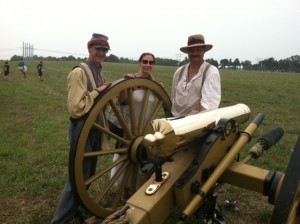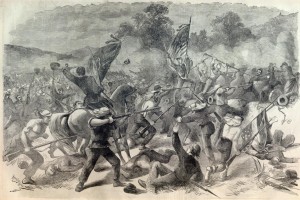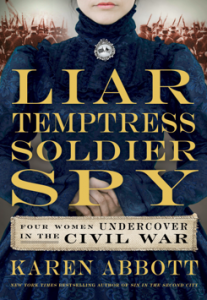By Karen Abbott (Regular Contributor)
July 21, 1861, saw the first major battle of the Civil War: The Battle of Bull Run (called Manassas in the South). President Lincoln was counting on a decisive victory to quell the rebellion, then only three months along. But Rose O’Neal Greenhow, one of the Confederate spies I feature in my book, Liar, Temptress, Soldier, Spy, provided the rebel army with crucial information that led to its shocking victory. When the 150th anniversary reenactment of this battle took place, I was there.
Witnessing History
At 9 a.m. on Sunday, July 24, 2011, a phalanx of shuttle buses lined up at the Jiffy Lube Live amphitheater in Bristow, Virginia, waiting to transport twenty-five thousand Civil War aficionados to the reenactment, a two-hour production in 93 degree heat. They came from all over the country: men sweating in period muslin undergarments and wool frock coats; women wearing swinging hoop skirts and calico hats; squealing babies swaddled in Confederate-style onesies. After a ten-minute ride, during which spectators sipped iced Frappuccinos and watched an educational video about the significance of this event, the caravan arrived at Pageland Farm, a 200-acre spread adjacent to the actual battlefield.
People jockeyed for prime seats on the bleachers. One woman yanked on a volunteer’s sleeve. “I was told there would be bleachers in the shade,” she said. “Where are they?” The volunteer shrugged and directed her to the information table. One row back, a father turned to his son, about twelve years old. “You gotta know the battlefield,” he scoffed. “Who asks for bleachers in the shade?”
Reenactment and Its (Dis)Contents
On crisp, yellowed grass, 9,000 Confederate and Federal troops wielded authentic smoothbore muskets and hunched over cannons, wrapping gunpowder in aluminum foil. A man from the 6th North Carolina napped near the sidelines. The cheery sounds of “Dixie” drifted from a fife, and a ten-year-old drummer boy kept up a steady beat. Soldiers filled their caps with ice from plastic bags. An announcer came on the PA system to request that all cell phones be turned off. “Welcome to the battle,” he added, and it was on.
One hundred fifty years ago a hailstorm of cannon balls filled the sky; now the air remained clear save for waving flags and thick, drifting rings of smoke. “A soldier could look and find his regiment flag if he got separated from the group,” the announcer explained. “And look! Here comes the cavalry of J.E.B. Stuart.” The spectators wolf-whistled and applauded. Latecomers arrived carrying paper baskets of cheese fries and red-white-and-blue snow cones. On July 21, 1861, civilians arrived by carriage from Washington hoping to glimpse the carnage, dipping into picnic baskets and sipping champagne, waiting to toast a Union victory.
The bleachers shuddered at each crackle and boom. People brandished video cameras and iPhones and leaned forward. Confederate reserves arrived by horse, regiment after regiment, a furious vortex streaming in from all sides. General Thomas Jackson, who acquired the nickname “Stonewall” during this battle, appeared on the top of the Henry House Hill plateau. “The Army of the Shenandoah is on the battlefield,” the announcer intoned. “Jackson instructed his men to ‘yell like furies!’” The 21st century Jackson doppelganger instructed the same. The soldiers obliged and unleashed their “rebel yell,” the Confederate battle cry that Shelby Foote described as a “wildcat screech, foxhunt yip, banshee squall.”
Above the din, the son asked his father, “Wait… where’s Jackson?”
“Look over there by the power lines,” the fathered replied, pointing. “There’s the man who’s portraying him.”
“Duh,” the kid said.
The announcer’s voice grew ominous. “The tide of battle is beginning to turn,” he intoned. “The Federals are retreating.” Rows of men in dark blue marched calmly toward the general direction of Washington. The fife player switched to “Yankee Doodle.”
A woman in the front row shielded her eyes with her hand, squinting at the field. “Why is no one dying?” she asked her companion. “Never mind—there’s one on the ground.”
As if on cue, the dead soldier, in a last full measure of devotion, reached his hand back and scratched his ass.
With every boom of cannon the spectators cheered louder. One woman circled a corndog above her head.
“It’s not historically accurate,” the man told his son, “but there’s Robert E. Lee coming down the field.”
“Are you having a good battle, general?” the announcer asked, and General Lee raised an arm. “I’ll take that as a yes.”
One Confederate solider helped a wounded comrade off the field, gripping his arm as he limped along. “All right, that’s good enough,” the wounded man said as they passed by the bleachers. A volunteer offered a bottle of water, donated by Prince William Hospital.
“Many Washington politicians,” the announcer explained, “came down with their wives and families to see the battle and got mingled with the Federals on their retreat. Congressman Alfred Ely from New York was captured by the Confederates, hiding behind a tree.”
“What an asshole,” the kid said.
“Duh,” the dad retorted.
Two hours after the first shot, spectators began stomping down bleachers, heading back toward the direction of Jiffy Lube Live. The retreat to the idling, air-conditioned shuttle buses was slow but orderly. None of them drowned in the creek or slipped on grass slick with blood, as they had at First Manassas.
“Ladies and gentlemen,” the announcer called, “you have just witnessed a glimpse of what it might have been like here in 1861. Please let’s have a round of applause for their efforts.”
The remaining crowd shouted half-hearted “Huzzahs,” muted by the effects of the soaring heat.
“Thank you for attending the 150th reenactment of First Manassas,” the announced concluded. “Don’t forget to get your souvenir programs. And there will be a program at 1 p.m. in Tent One called “The Scourge of Slavery: the Frederick Douglass Story.”
“Let’s go watch Gods and Generals now,” the kid said.
The last of the fallen reenactors rose, brave patriots eager to share a cold beer with their countrymen, and the wisps of smoke looped faintly around the trees.
Karen Abbott is the New York Times bestselling author of Sin in the Second City and American Rose. Her forthcoming book about female Civil War spies, Liar, Temptress, Soldier, Spy, will be published by HarperCollins on September 2.
In collaboration with Wonders& Marvels, Karen Abbott is hosting a special newsletter with giveaways and sneak peeks for LIAR, TEMPTRESS, SOLDIER, SPY. Be sure to subscribe below!



